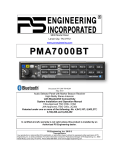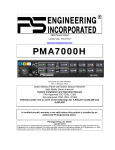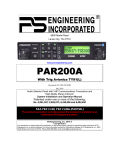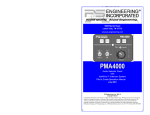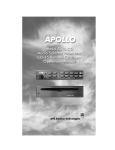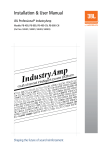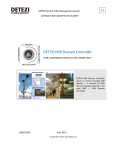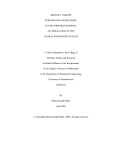Download Honeywell KMA 29 User's Manual
Transcript
KMA 29 PG Front Cover 9/7/07 2:08 PM Page 1 n KMA 29 AUDIO PANEL Pilot’s Guide Revision 1 Sep/2007 006-18303-0000 KMA 29 PG Front Cover 9/7/07 2:08 PM Page 2 The information contained in this manual is for reference use only. If any information contained herein conflicts with similar information contained in the Airplane Flight Manual Supplement, the information in the Airplane Flight Manual Supplement shall take precedence. WARNING The enclosed technical data is eligible for export under License Designation NLR and is to be used solely by the individual/organization to whom it is addressed. Diversion contrary to U.S. law is prohibited. COPYRIGHT NOTICE Copyright © 2006, 2007 Honeywell International Inc. All rights reserved. Reproduction of this publication or any portion thereof by any means without the express written permission of Honeywell International Inc. is prohibited. For further information contact Aerospace Technical Publications; Honeywell Business & General Aviation; One Technology Center; 23500 West 105th Street; Olathe, Kansas 66061. Telephone: (913) 712-0400. Revision History and Instructions Manual KMA 29 Audio Panel Pilot’s Guide Revision 1, September 2007 Part Number 006-18303-0000 Summary Added paragraphs on dual KMA 29 operation on page 12. Updated instructions on the soft mute inhibit on page 17. R-1 Revision History and Instructions Manual KMA 29 Audio Panel Pilot’s Guide Revision 0, February 2006 Part Number 006-18303-0000 Summary This is the original release of this publication. R-2 Table of Contents INTRODUCTION . . . . . . . . . . . . . . . . . . . . . . . . . . . . . . . . . . . . . . . . . . . . . . 1 ACRONYMS AND ABBREVIATIONS . . . . . . . . . . . . . . . . . . . . . . . . . . . 2 AUDIO PANEL DESCRIPTION . . . . . . . . . . . . . . . . . . . . . . . . . . . . . . . . . 3 AUDIO PANEL CONTROLS . . . . . . . . . . . . . . . . . . . . . . . . . . . . . . . . . . . . 5 SPKR/PA (SPEAKER/PASSENGER ADDRESS) SWITCH . . . . . . . . . . . 6 COM MIC (MICROPHONE) SELECTOR BUTTONS . . . . . . . . . . . . . . . . 6 SPLIT MODE BUTTON . . . . . . . . . . . . . . . . . . . . . . . . . . . . . . . . . . . . . 7 CREW/PAX ICS VOL KNOB AND PUSH EMG/OFF SWITCH . . . . . . . . . 8 CREW/PAX ICS VOL (Crew/Passenger Intercom System Volume) Knob . . . . . . . . . . . . . . . . . . . . . . . . . . . . . . . . . . . . . . . . . 8 PUSH EMG/OFF (Power On and Emergency/Off) Switch . . . . . . . . . . 8 ICS (INTERCOM SYSTEM) BUTTON . . . . . . . . . . . . . . . . . . . . . . . . . . 8 COM AUDIO SELECTOR BUTTONS . . . . . . . . . . . . . . . . . . . . . . . . . . . 9 NAVIGATION RADIO AUDIO (NAV, ADF, DME, AUX AND MKR) SELECTOR BUTTONS . . . . . . . . . . . . . . . . . . . . . . . . . . . . . . . . . . . . . 9 NAV1, NAV 2, ADF 1, ADF 2, DME 1 AND DME 2 Buttons . . . . . . . . 9 AUX Button . . . . . . . . . . . . . . . . . . . . . . . . . . . . . . . . . . . . . . . . . . . 9 MKR Button . . . . . . . . . . . . . . . . . . . . . . . . . . . . . . . . . . . . . . . . . . . 9 MKR SENS (MARKER BEACON SENSITIVITY) BUTTON . . . . . . . . . . 10 MKR MUTE/TEST (MARKER BEACON MUTE/TEST) BUTTON . . . . . . 10 AUDIO PANEL OPERATION . . . . . . . . . . . . . . . . . . . . . . . . . . . . . . . . . . 11 COM MICROPHONE OPERATION . . . . . . . . . . . . . . . . . . . . . . . . . . . . 11 COMMUNICATION AND NAVIGATION AUDIO OPERATION . . . . . . . . 12 DUAL KMA 29 OPERATION . . . . . . . . . . . . . . . . . . . . . . . . . . . . . . . . 12 EMERGENCY OPERATION . . . . . . . . . . . . . . . . . . . . . . . . . . . . . . . . . 12 MARKER BEACON OPERATION . . . . . . . . . . . . . . . . . . . . . . . . . . . . . 13 SPLIT MODE OPERATION . . . . . . . . . . . . . . . . . . . . . . . . . . . . . . . . . 14 Rev. 1 Sep/07 KMA 29 Audio Panel Pilot’s Guide i Table of Contents INTERCOM OPERATION . . . . . . . . . . . . . . . . . . . . . . . . . . . . . . . . . . 15 ENTERTAINMENT SYSTEM OPERATION . . . . . . . . . . . . . . . . . . . . . . 16 Entertainment Soft Mute and Soft Mute Inhibit Modes . . . . . . . . . 17 TELEPHONE MODE OPERATION . . . . . . . . . . . . . . . . . . . . . . . . . . . . 18 ii KMA 29 Audio Panel Pilot’s Guide Rev. 1 Sep/07 N Introduction INTRODUCTION All of us at Honeywell congratulate you on choosing this product. You are now the owner of an outstanding audio system. We understand that you probably can’t wait to see it in action, but before you try to use it please take the time to read through this manual and understand its many interesting and useful features. Time spent in familiarizing yourself with your new KMA 29 unit will be more than repaid by trouble-free operation later. This Pilot’s Guide will be of great help to you. It is written in plain, simple English and it assumes that you are not an experienced user of the audio system. If you are experienced, then even better. It is designed so you can start at the front of the manual and progress in the order presented; however, you may want to skip around and learn things in your own order. Throughout this manual, it is assumed that the pilot sits on the left side of the aircraft and the copilot sits on the right side. Any reference to a left arrow indication refers to the pilot side and a right arrow indication refers to the copilot side. Rev. 0 Feb/06 KMA 29 Audio Panel Pilot’s Guide 1 N Introduction ACRONYMS AND ABBREVIATIONS ADF: Automatic Direction Finder AUX: Auxiliary COM: Communication DME: Distance Measuring Equipment EMG: Emergency HI: High ICS: Intercom System ILS: Instrument Landing System ISO: Isolated LED: Light Emitting Diode LO: Low MIC: Microphone MKR: Marker NAV: Navigation PA: Passenger Address PAX: Passenger PFD: Primary Flight Display PTT: Push-to-Talk SENS: Sensitivity SPKR: Speaker TAWS: Terrain Awareness Warning System VHF: Very High Frequency VOL: Volume VOX: Voice Activation 2 KMA 29 Audio Panel Pilot’s Guide Rev. 0 Feb/06 N Audio Panel Description AUDIO PANEL DESCRIPTION The KMA 29 audio control panel provides audio system control for the cockpit crew and passengers. The panel also provides an interface to the passenger address (PA) system and aural warning system. The audio panel also includes a marker beacon receiver. The audio panel is used to make audio selections for all audio communications to and from the cockpit crew. The audio panel receives inputs from all audio communication channels and aural warnings. Audio outputs from the panel include a cockpit speaker and headphone jacks. Noise-canceling headsets can be used with the audio panel. The audio panel provides the following functions: • Speaker control • Five (5) very high frequency (VHF) communication (COM) transceivers • Split single panel or dual panel (independent) operation • Intercom system operation with automatic voice activation (VOX) • Eight (8) navigation receivers as follows: - Two (2) navigation (NAV) - Two (2) automatic direction finder (ADF) - Two (2) distance measuring equipment (DME) - One (1) auxiliary (AUX) - One (1) marker beacon (MKR). • Marker beacon mute/test and sense control • Processing and routing of the aural warnings generated from external sources or systems • Four (4) unswitched audio inputs • Entertainment system (optional) • Telephone operation (optional). Rev. 0 Feb/06 KMA 29 Audio Panel Pilot’s Guide 3 Audio Panel Description N There are four unswitched inputs (aircraft hard-wired and configured) available for traffic or terrain awareness warning system (TAWS), autopilot disconnect, and/or radar altimeter warning. The audio panel always supplies the audio from one or two of the audio inputs to the pilot’s and copilot’s headset and cockpit speakers outputs during normal operation. Momentary push-button switches are used to select one of the COM transceivers for the pilot and copilot position, which allows radio transmission. In the Split Mode, the pilot has the ability to transmit on one COM, while the copilot can transmit on another COM. A fail-safe mode connects the pilot headphone and microphone to COM 1 if power is removed for any reason, or if the power switch is placed in the OFF (fail-safe) position. A six-station VOX intercom is included in the KMA 29 system. This system has a patented IntelliVox® circuitry that eliminates manual adjustments. The system contains six separate VOX microphone circuits and only opens the microphone channel that is in use. The intercom system incorporates pilot isolate mode, all crew mode, two independent stereo music inputs with Soft Mute, and light emitting diode (LED) indications. Intercom control is through a concentric front panel volume control and a push-button intercom mode switch. The small volume knob controls the intercom level for the pilot and copilot while the large knob controls the passenger intercom volume. The intercom squelch is automatic. A marker beacon receiver is integrated in the KMA 29 audio panel. This provides the necessary marker beacon signal outputs to the display and audio indications necessary for an instrument landing system (ILS) approach. The push-button labeled MKR allows the pilot to select the marker beacon mode of operation. The pilot can then select either high or low sensitivity using the marker beacon sensitivity (MKR SENS) button or mute the marker beacon audio by pushing the MUTE button. The marker beacon can be tested by selecting and holding the MKR MUTE/TEST button for five seconds. The aircraft system uses the marker beacon receiver information supplied by the audio panel to generate status displays. 4 KMA 29 Audio Panel Pilot’s Guide Rev. 0 Feb/06 N Audio Panel Controls AUDIO PANEL CONTROLS The front panel drawing of the audio panel is shown below. The controls include the following: • SPKR/PA (Speaker/Passenger Address) Switch • COM MIC (Microphone) Selector Buttons • SPLIT Mode Button • CREW/PAX ICS VOL (Crew/Passenger Intercom System Volume) Knob • PUSH EMG/OFF (Power On and Emergency/Off) Switch • ICS (Intercom System) Button • COM AUDIO Selector Buttons • Navigation Radio Audio (NAV, ADF, DME, AUX and MKR) Selector Buttons • MKR SENS (Marker Beacon Sensitivity) Button • MKR MUTE/TEST (Marker Beacon Mute/Test) Button. ON OFF ICS VOL PA CREW SPKR/PA COM 1 COM 2 COM 3 COM 4 COM 5 COM 4 COM 5 PAX S P LI T MIC ISO ALL CREW ICS NAV 1 COM 1 COM 2 COM 3 PUSH EMG/OFF MKR MUTE/TEST AUDIO NAV 2 ADF 1 ADF 2 DME 1 DME 2 AUX MKR N MKR SENS HI LO KMA 29 Audio Panel Rev. 0 Feb/06 KMA 29 Audio Panel Pilot’s Guide 5 Audio Panel Controls N SPKR/PA (SPEAKER/PASSENGER ADDRESS) SWITCH The SPKR/PA switch has three functions: • Speaker ON • Speaker OFF • Passenger address system ON. The SPKR/PA rocker switch can be pushed to the left or right. Each time the right side of the switch is pushed, the mode changes from left to right as indicated by the light emitting diodes (LEDs) and does not wrap around. Each time the left side of the switch is pushed, the mode changes from right to left as indicated by the LEDs and does not wrap around. Pushing the SPKR/PA switch toggles between the following selections: • ON - The ON light is illuminated, all selected audio will come over the cockpit speaker (headset audio is always on). • OFF - The OFF light is illuminated, no audio is available over the cockpit speaker (headset audio is always on). • PA - The PA light is illuminated; the pilot can transmit through the microphone to the passenger cabin speaker. The normal microphone push-to-talk (PTT) switch is used for the PA function. The copilot can continue to use the selected COM radio while the pilot is heard over the speaker. The pilot’s microphone has priority if both the pilot and copilot PTT switches are pressed at the same time and both audio panels are on PA. COM MIC (MICROPHONE) SELECTOR BUTTONS The microphone input selector buttons are located along the upper edge of the audio panel. The buttons are dedicated, momentary-action, push buttons. 6 KMA 29 Audio Panel Pilot’s Guide Rev. 0 Feb/06 N Audio Panel Controls The COM 1 through COM 5 MIC buttons are used to select the associated radio transmitter. The receiver audio for the selected transmitter is automatically selected. A lighted arrow located above each button indicates that the button has been pressed and that the mode is active for the left (pilot) side, right (copilot) side, or both sides. This depends upon the mode of the audio panel operation split or duplex mode. Refer to the Split Mode Operation in this Pilot’s Guide for additional information on the Split Mode. COM 5 can be configured for duplex, which simulates the operation of a telephone. Refer to the Telephone Mode Operation in this Pilot’s Guide for additional information on the Telephone Mode. SPLIT MODE BUTTON NOTE: The Split Mode is used only in a single audio panel environment. It allows the pilot and copilot to transmit and receive on different COM radios. The audio panel has two modes of operation, Normal and Split. In the Normal Mode the pilot and copilot transmit on the same selected COM radio. The Split Mode operation allows the pilot and copilot to transmit and receive on separate COM radios. The SPLIT Mode button is a rocker switch used to select which crew member is on a given radio. The selection is initiated by pressing the left (pilot) side or right (copilot) side of the SPLIT button. The LED above the SPLIT button indicates who can select the COM radio for transmission. For example, the SPLIT Mode button that is shown above illustrates that the copilot is making the COM selection. The person in control can then select the specific COM radio to be connected to that person’s PTT switch. The LED located above each COM button indicates which PTT switch is connected to that radio. When the Split Mode is active, the split operation can be toggled between the pilot and copilot by pushing the desired side of the SPLIT button. The audio panel remains in the Split Mode until it is cancelled by the pilot and copilot selection of the same COM MIC radio. Rev. 0 Feb/06 KMA 29 Audio Panel Pilot’s Guide 7 Audio Panel Controls N CREW/PAX ICS VOL KNOB AND PUSH EMG/OFF SWITCH CREW/PAX ICS VOL (CREW/PASSENGER INTERCOM SYSTEM VOLUME) KNOB The CREW/PAX ICS VOL knob control adjusts the loudness of the intercom only. Turning the inner knob clockwise and counterclockwise sets the volume of the headphone up or down respectively for the CREW intercom. Turning the outer knob controls the speaker or headphone volume for the passengers (PAX) intercom. It has no effect on selected radio levels, music input levels or passengers’ volume level. PUSH EMG/OFF (POWER ON AND EMERGENCY/OFF) SWITCH NOTE: In the event of a failure or loss of power to the audio panel, the PUSH EMG/OFF power switch should be pressed. When pressed, both pilots’ microphones are directly connected to the COM 1. The audio panel power is turned on and off by pushing the PUSH EMG/OFF power switch. The power switch has two positions which are On and EMG/OFF. The On position is not labeled on the switch but it is implied On when not in the EMG/OFF position. The switch position is the same for Emergency and Off and the modes of operation are identical. Refer to the Emergency Operation in this Pilot’s Guide for additional information. The power switch also controls the intercom, audio selector panel functions, and marker beacon receiver. ICS (INTERCOM SYSTEM) BUTTON The ICS selector button enables communication between the pilot, copilot and all passengers that are on a headset. The ICS rocker switch cycles through the intercom modes, left to right or right to left, and wraps around. An LED shows the active mode. Refer to Intercom Operation in this Pilot’s Guide for additional information about the intercom modes (Isolated [ISO], All and Crew). The intercom volume is controlled by the CREW/PAX ICS VOL Knob. Refer to the CREW/PAX ICS VOL (Crew/Passenger Intercom System Volume) Knob paragraph in this Pilot’s Guide for additional information. 8 KMA 29 Audio Panel Pilot’s Guide Rev. 0 Feb/06 N Audio Panel Controls COM AUDIO SELECTOR BUTTONS The COM 1 through COM 5 AUDIO buttons are used to select the associated receiver audio. The selected transmitter receive audio is automatically selected. Pressing a button turns on the associated radio audio. The pilot can identify which receivers are selected by noting which of the green lights are illuminated. NAVIGATION RADIO AUDIO (NAV, ADF, DME, AUX AND MKR) SELECTOR BUTTONS NAV 1, NAV 2, ADF 1, ADF 2, DME 1 AND DME 2 BUTTONS Pressing a button turns on the associated navigation receiver audio. When selected, the associated LED is illuminated. AUX BUTTON The AUX button selects the entertainment audio. The green LED above the button illuminates when entertainment audio is selected to be heard. Refer to the Entertainment System Operation of this Pilot’s Guide for additional information. MKR BUTTON When the MKR button is pressed, the LED above the button is illuminated. The MKR button enables the visual indications on the primary flight display (PFD) and the audio indicator when the aircraft passes over a 75-MHz marker beacon transmitter. Rev. 0 Feb/06 KMA 29 Audio Panel Pilot’s Guide 9 Audio Panel Controls N When the LED above the MKR button is OFF, the marker audio is muted. The visual indications on the PFD will still operate when the aircraft passes over the marker. MKR SENS (MARKER BEACON SENSITIVITY) BUTTON The MKR SENS button controls the marker beacon receiver sensitivity. The button alternates between the HI and LO settings. The LEDs indicate which sensitivity is selected, as follows: • HI - High sensitivity allows the pilots hear the outer marker approximately one mile from the beacon. • LO - Low sensitivity provides a more accurate location of the marker. When used only for approach markers, many pilots choose to leave the switch in the low sensitivity position. MKR MUTE/TEST (MARKER BEACON MUTE/TEST) BUTTON When the MKR MUTE/TEST button is pressed and released, the marker beacon audio is muted for that marker beacon. The muting continues until one of the following events occurs: • A marker tone is detected that is different from the one that was present when the MUTE button was pressed. • The audio panel is turned OFF. • If MUTE is pressed prior to crossing the marker beacon, the mute will be held for 60 seconds and then timeout. When the MKR MUTE/TEST button is pressed and held for five seconds, the marker beacon discretes go high for one second. 10 KMA 29 Audio Panel Pilot’s Guide Rev. 0 Feb/06 N Audio Panel Operation AUDIO PANEL OPERATION The audio panel receives audio from remote radio units, decodes the audio, controls the gain (volume) and routing of the various channels, filters audio signals, and output the audio to various speakers and headphones. It controls microphone inputs to various radios, intercom and passenger address systems. Amplifiers are included for driving headphones and speakers. The audio panel also has inputs for intercom, crew annunciator, crew communication, hot microphones and full time emergency warning inputs from aircraft systems. COM MICROPHONE OPERATION When a microphone selector button is selected and PTT switch is enabled, the pilot’s or copilot’s microphone signal is routed to that radio’s microphone input. Pressing the MIC selector button to enable a particular COM also causes the audio for that particular COM to be automatically enabled. Above each microphone input selector button are left and right arrow LEDs that show the status of the respective COM transceiver. The left arrow is lit when that particular COM transceiver is assigned to the pilot. The right arrow is lit when that particular COM transceiver is assigned to the copilot. Only one COM microphone output can be active for the pilot or copilot at a time with two exceptions. The two exceptions are Split Mode and Telephone Mode (or Duplex Mode) operation. Refer to Split Mode Operation and Telephone Mode Operation in this Pilot’s Guide for additional information. When switching between COMs, such as from COM 1 to COM 2 (while COM 2 AUDIO has been selected), COM 1 audio will continue to be heard. This eliminates the need for the pilot to switch the COM 1 audio back on, if desired. When switching from COM 1 to COM 2 (while COM 2 AUDIO has not been selected), COM 1 audio is switched off. This means that switching the COMs does not affect the selection of the COM receiver audio. The audio panel gives priority to the pilot’s PTT switch. If the copilot is transmitting and the pilot presses the PTT switch, the pilot’s microphone is heard over the selected COM transmitter. Rev. 0 Feb/06 KMA 29 Audio Panel Pilot’s Guide 11 Audio Panel Operation N COMMUNICATION AND NAVIGATION AUDIO OPERATION Pressing any of the communication (COM) or navigation (NAV, ADF, DME, AUX, or MKR) audio selector buttons enables the associated audio and the LED above the button is lit. Pressing the same audio selector button again turns the audio for that channel and the LED above the button off. The pilot and copilot can select and listen to more than one communication or navigation audio at a given time. DUAL KMA 29 OPERATION When two KMA 29 audio panels are installed, both have access to the communications transceivers. When both panels have selected the same transmitter, the KMA 29 designated as the pilot position has priority. Indication arrows above the microphone selectors indicate which side has selected the radio for transmit. Offside radio indication is user selectable. When the offside indication is off, only the mic select arrow for the KMA 29 position is active. When on, the pilot can see which radio the copilot has selected for transmit, and vice versa, by noting which of the arrows is illuminated. To toggle the offside transmit selection indication, press the right side of the SPLIT button three (3) times within one and a half (1 1/2) seconds. When the mode is activated, the NAV 1 indicator blinks once. When the mode is toggled off, the NAV 1 indicator blinks twice. This mode remains in effect until changed by the user, including power cycles. EMERGENCY OPERATION NOTE: In the event of a failure or loss of power to the audio panel, the PUSH EMG/OFF power switch should be pressed. When pressed, both pilots’ microphones are directly connected to the COM 1. The PUSH EMG/OFF (Power On and Emergency/Off) switch is a two position switch. One position is On (implied) and the other position is EMG/OFF. The Emergency and Off modes of operation are identical. In the EMG/OFF position, the pilot is connected directly to COM 1 transmit and COM 1 receive through the headphones only. This allows com- 12 KMA 29 Audio Panel Pilot’s Guide Rev. 1 Sep/07 N Audio Panel Operation munication capability regardless of the condition of the unit. Any time power is removed or turned off, the audio selector is placed in the EMG mode. In the EMG mode, one or two of the unswitched audio inputs are supplied to the pilot headset. Also, in the EMG mode, audio signals are present in only one ear of a stereo headset. MARKER BEACON OPERATION The marker beacon receiver uses visual and audio indicators to alert the crew when the aircraft passes over a 75 MHz transmitter. There is a service adjustment located on the unit for ground maintenance to adjust the marker audio volume level. The outer, middle and inner marker indications are shown on an external display. The audio panel supplies a 400-Hz “dash” audio tone for the outer marker. The outer marker tone is keyed at a rate of two tones/flashes per second when the aircraft is in the range of the outer marker beacon. The panel provides a 1300-Hz tone for the middle marker, which is keyed alternately with short “dot” and long “dash” bursts at 95 combinations per minute. The audio panel supplies a 3000Hz “dot” tone for the inner marker. The inner marker tone is keyed at a rate of six times per second. The MKR SENS button is used to set the receiver sensitivity and to test the marker beacon. Use high (HI) sensitivity initially. This allows you to hear the outer marker beacon about a mile out. Then push the MKR SENS button to switch into the low (LO) sensitivity mode. Low sensitivity gives you a more accurate location of the marker. Many pilots choose to leave the button in the low sensitivity mode. Pressing and releasing the MKR MUTE/TEST button causes the marker audio to mute for that beacon. The muting continues until one of the following events occurs: 1. A marker tone is detected that is different from the one that was present when MUTE was initiated or if the same tone returns after a delay. (The delay accounts for a tone that fades and then comes right back. The MUTE is reset if the aircraft is flown out of the current tone and then back in.) 2. The audio panel is turned OFF. 3. If MUTE is pressed prior to crossing the marker beacon, the mute will continue for 60 seconds and then timeout. Rev. 1 Sep/07 KMA 29 Audio Panel Pilot’s Guide 13 Audio Panel Operation N Pressing and holding the MKR MUTE/TEST button for five seconds causes the marker beacon discretes to go high for one second in order to test the marker beacon. The marker beacon annunciations are shown on an external display. SPLIT MODE OPERATION NOTE: The Split Mode is used only in a single audio panel environment. It allows the pilot and copilot to transmit and receive on different COM radios. The typical Split Mode operation is as follows: 1. Both pilot and copilot are on COM 1 microphone (as indicated by both the left and right arrows being lit on COM 1). 2. To split to COM 2, the pilot pushes the pilot side (left side) of the SPLIT button. The LED above the pilot side of the SPLIT button lights, indicating the SPLIT mode is initiated. 3. The pilot then presses COM 2 microphone. The pilot arrow indicator above the COM 2 microphone lights. The pilot is now connected to the COM 2 microphone. 4. The pilot access indicator on the COM 1 microphone turns off, leaving the copilot with sole access to the COM 1 microphone. 5. The intercom system (ICS) modes changes to isolated (ISO). The pilot indicator over the SPLIT button turns off. When the Split Mode is activated, the intercom automatically reverts to the Isolated Mode. However, the ICS button can be used to enable the Crew and All modes for intercommunications. To exit the Split Mode, the pilot and copilot should select the same COM MIC button. The Split Mode operation permits one user to enable both COM 5 and any other COM (1 thru 4), while simultaneously allowing the other user to select one of the remaining COMs (1 thru 4). The following is an example of this configuration: • The pilot selects COM 5 (Telephone) and COM 1 MIC (Microphone). • The copilot enables the Split Mode by pressing the right side (copilot side) of the SPLIT button. • The copilot then selects COM 2 MIC. 14 KMA 29 Audio Panel Pilot’s Guide Rev. 1 Sep/07 N Audio Panel Operation INTERCOM OPERATION The intercom system is an IntelliVox® automatic voice activated system. The IntelliVox® circuitry eliminates the need for manual adjustments of the squelch. Through three individual signal processors, the ambient noise appearing in all six microphones is constantly being sampled. Non-voice signals are blocked. When someone speaks, the microphone circuit opens, placing their voice on the intercom. The system is designed to block continuous tones, therefore, someone humming or whistling in monotone may be blocked after a few moments. For consistent performance, any headset microphone must be placed within 1/4 inch of your lips, preferably against them. It is also a good idea to keep the microphone out of a direct wind path. Moving your head through a vent air stream may cause the IntelliVox® to open momentarily. This is normal. For optimum microphone performance, Honeywell recommends installation of a Microphone Muff Kit from Oregon Aero (1-800-888-6910) or equivalent. This will not only optimize VOX acoustic performance, but will also improve the overall clarity of all your communications. The volume control for the intercom is the CREW/PAX ICS VOL knob. Refer to the CREW/PAX ICS VOL (Crew/Passenger Intercom System Volume) Knob paragraph in this Pilot’s Guide for additional information. All passenger headsets are connected in parallel. If a monaural headset is plugged in to a KMA 29 installation, one channel is shorted. Although no damage will occur to the unit, all passengers will lose one channel unless they switch to the MONO mode on the headset. The intercom modes are given in the following table: Rev. 0 Feb/06 KMA 29 Audio Panel Pilot’s Guide 15 N Audio Panel Operation Mode Pilot Hears Copilot Hears Passenger Hears Comments ISO Selected aircraft Copilot and pas- Passenger and This mode allows the radios senger intercom copilot intercom pilot to communicate without the others Pilot sidetone Entertainment 1 Entertainment 2 being bothered by (during radio the conversations. transmission) The copilot and passengers can continEntertainment 1 ue to communicate is muted and listen to music. ALL Pilot Copilot Passengers CREW Pilot Copilot Passengers This mode allows all on board to hear Copilot Pilot Pilot radio receptions as well as the ability to Selected aircraft Selected aircraft Copilot communicate on the radio radio Selected aircraft intercom. Music and intercom are muted Passengers Passengers radio during intercom and Entertainment 1 Entertainment 1 Entertainment 2 radio communications. This mode allows the pilot and copilot to Copilot Pilot Entertainment 2 concentrate on flying, while the pasSelected aircraft Selected aircraft sengers can commuradio radio nicate amongst themselves. Entertainment 1 Entertainment 1 ENTERTAINMENT SYSTEM OPERATION The KMA 29 audio panel has provisions for two separate entertainment inputs. Entertainment 1 (or Music 1) feeds the pilot and copilot positions, which operate independently in the audio panel. The CREW/PAX ICS VOL knob does not affect the music level. Most general aviation headsets today have built-in volume controls; therefore, the music volume can be adjusted at the headset. Entertainment 2 (or Music 2) is fed to the passengers. The passenger music also operates independently of the crew (Music 1). 16 KMA 29 Audio Panel Pilot’s Guide Rev. 0 Feb/06 N Audio Panel Operation While in the intercom ISO mode, Entertainment 1 is muted for the pilot. The copilot hears Entertainment 1 at a normal level. The music automatically mutes when either the copilot or passengers speak and then gradually returns to the original listening level when the intercom or radio conversation ceases. The pilot does not mute the music while in the ISO mode if the PTT switch is pressed to transmit or if the pilot speaks while on the phone. When in the intercom ALL mode, Music 1 mutes automatically with a Soft Mute, or can be placed in Soft Mute Inhibit Mode, which is described below. The passengers can disable their music muting with an external switch that may have been installed during installation. While in the intercom CREW mode, the pilot and copilot hear Entertainment 1, while the passengers hear Entertainment 2. ENTERTAINMENT SOFT MUTE AND SOFT MUTE INHIBIT MODES The Soft Mute feature assures that the aircraft radio transmissions are not missed due to playing entertainment. When there is radio reception or intercom conversation, the music level is decreased gradually to a very low level. When the radio or intercom traffic ceases, the level gradually returns back to normal. The KMA 29 audio panel is equipped with a Soft Mute inhibit capability. This allows the music to continue uninterrupted by intercom or radio traffic when the cockpit workload is appropriate. To inhibit the Soft Mute, press the MKR MUTE/TEST button three (3) times within one and a half (1 1/2) seconds. The NAV 1 indicator blinks once to indicate that the Soft Mute inhibit is on, and blinks twice when the Soft Mute inhibit mode is turned off (music mutes with radio or intercom conversation). The passenger music, which is Entertainment 2, can be placed in the mute inhibit mode by a switch that is installed in the aircraft. Rev. 1 Sep/07 KMA 29 Audio Panel Pilot’s Guide 17 Audio Panel Operation N TELEPHONE MODE OPERATION When enabled in the installation, COM 5 serves as a full duplex interface for telephone systems. When interfaced with specific aircraft approved FAA/FCC cellular telephone equipment, the audio panel can serve as an audio control and distribution center. The audio panel acts as an audio interface between aircraft headphone and microphones and telephone. The pilot selects telephone by selecting COM 5 on the audio panel. The copilot and passengers each have an external hook switch to allow them to use the telephone. When COM 5 is configured for duplex and is selected, the pilot microphone and headphones are connected to the phone. The pilot PTT switches the pilot microphone to the selected COM transceiver and allows continued aircraft communications. The copilot is able to transmit on the other selected radio with the copilot PTT switch as well. When the KMA 29 audio panel is configured for COM 5 duplex operation, it functions as follows: 1. The pilot selects telephone by selecting COM 5 on the audio panel. 2. The copilot selects telephone using the external copilot hook switch. 3. The passengers select telephone using the external passenger hook switch. NOTE: The use of non-aviation approved cellular telephone equipment may be prohibited by regulation. Honeywell is not responsible for unauthorized airborne use of cellular telephones. For airborne use, the KMA 29 audio panel must be interfaced with an approved system. 18 KMA 29 Audio Panel Pilot’s Guide Rev. 0 Feb/06 KMA 29 PG Back Cover 9/7/07 2:06 PM Page 1 KMA 29 PG Back Cover 9/7/07 2:06 PM Page 2 Honeywell Aerospace Business and General Aviation Honeywell International Inc. One Technology Center 23500 West 105th Street Olathe, KS 66061 Telephone: (913) 712-0400 FAX: (913) 712-1302 www.honeywell.com 006-18303-0000 Rev. 1 09/07 © 2006, 2007 Honeywell International Inc. n


























